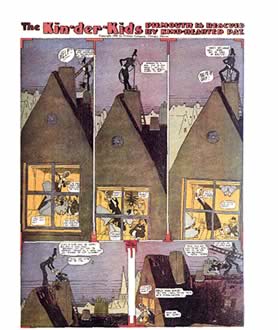










 |
 |
 |
 |
||||||||
 |
|||||||||||
 |
 |
 |
 |
||||||||
 |
 |
||||||||||
| Lyonel Feininger
(1871 - 1956) Feininger had been born in America to musician parents and
had gone to Berlin in 1886 to study music. There he began cartooning and
switched to the standard run of Academies and ateliers. In 1906 he was commissioned
to produce a strip for the Chicago Tribune . It ran only a short time because
he abandoned it in November that year (31 pages in toto). He was to join
the Bauhaus as a teacher and became increasingly slick as a painter of overlapping
planes of transparency. This is a revealing image of the cartoonist creating
his own personal world of characters ready to be deployed in narrative.
Daniel Webster and Chums will aim to escape Auntie Jim-Jams. Feininger returned
to the world of Kin-der-Kids in a set of wooden figures he created for an
imaginary city - the "City at the Edge of the World".
Feininger was really inventive with his panel structures, here three views of the Aunt with the Castor Oil through the gable end window, and the two images of the action on the roof. He avoids the fixed point-of-view with careful changes of angle. Look at the little frame supports he has devised to keep the panels together, inscribed "your Uncle Feininger". DOVER Books of New York reproduce the entire Kin-der-Kids in paperback form, 1980. |